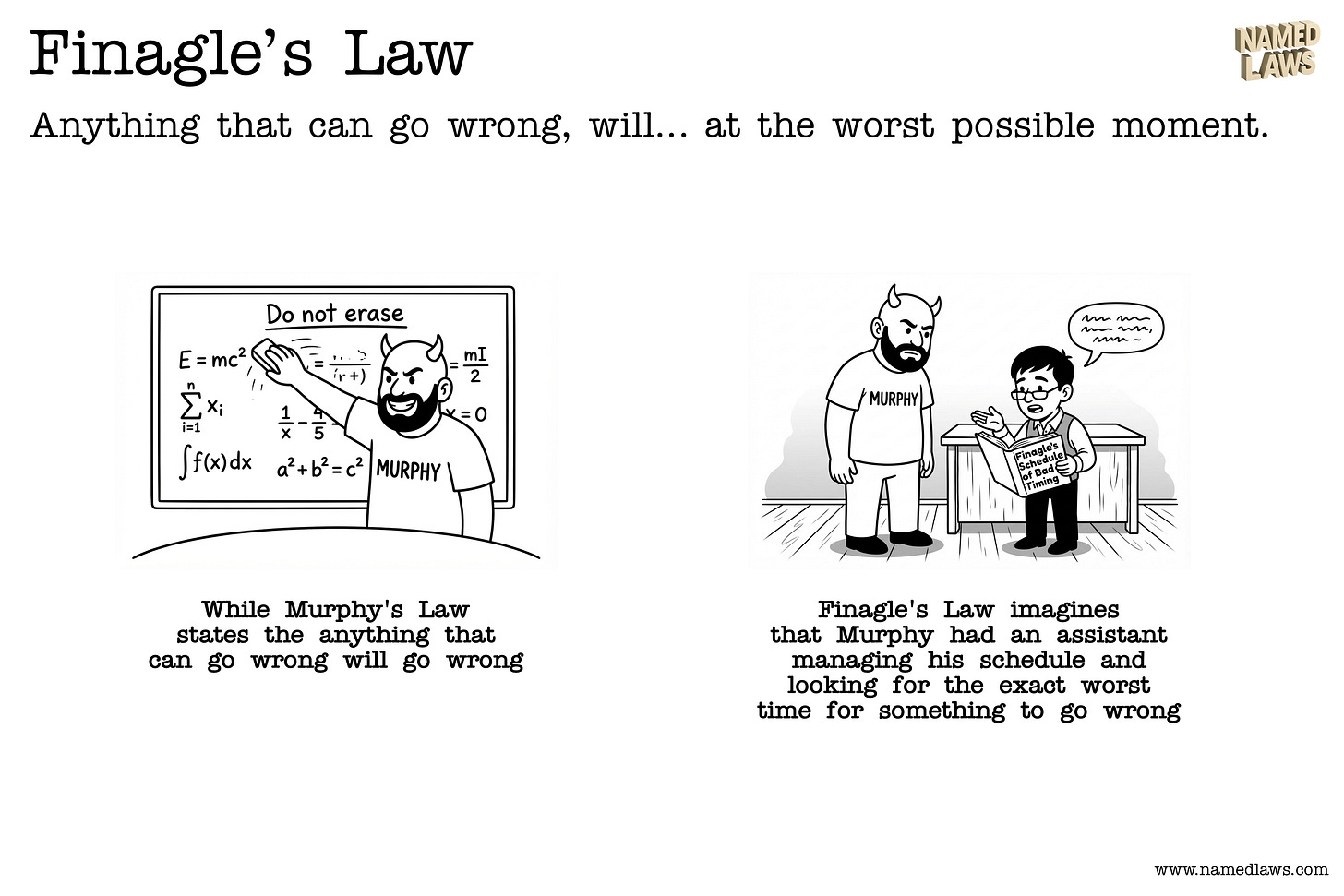Finagle’s Law
Why Your Simple Fix Just Crashed the Entire System on a Friday Afternoon
It’s 4:55 PM on a Friday. You’re a developer, and you’ve just spotted a tiny, insignificant bug. It’s a quick fix. A one-liner. You could leave it for Monday, but you’re a hero. You type the change, skip the full test suite because, come on, it’s a one-liner, and you push it to production.
You close your laptop with a satisfying click, ready for the weekend.
At 5:01 PM, your phone starts vibrating. It’s Slack. Then your boss calls. Then the CEO. The “simple fix” has somehow taken down the entire payment processing system. The site is on fire, the weekend is cancelled, and you’re the one holding the match.
You haven’t just had a bad day. You’ve just been personally victimized by a cruel, cynical, and deeply specific version of Murphy’s Law. A principle that says things don’t just go wrong; they go wrong at the most catastrophic moment imaginable.
It’s called Finagle’s Law.
The Origin Story: A Sci-Fi Editor’s Cynical Truth
The law was popularized by John W. Campbell Jr., the legendary editor of Astounding Science Fiction magazine in the mid-20th century. Campbell, who shaped the careers of writers like Isaac Asimov and Robert Heinlein, had a keen eye for how systems, both fictional and real, tend to fail in the most spectacular ways.
He frequently used the term in his editorials, offering a sharper, more pessimistic twist on the well-known Murphy’s Law. While Murphy’s Law states that “anything that can go wrong, will go wrong,” Finagle’s Law adds a diabolical dose of bad timing.
The law is often stated as:
Anything that can go wrong, will… at the worst possible moment.
It’s the universe’s cruel sense of comedic timing, formalized into a principle. It’s not just that the toast will fall; it’s that it will fall butter-side down, onto your new white carpet, two minutes before your in-laws arrive.
The Basic Explanation
Finagle’s Law is Murphy’s Law’s evil twin. It’s not just about the inevitability of failure; it’s about the perversity of failure. It suggests that the universe has a flair for the dramatic, and that problems don’t just occur, they make an entrance.
Let’s break down the difference:
Murphy’s Law: If you design a system with a flaw, that flaw will eventually be exposed. It’s a statement about probability and entropy.
Finagle’s Law: That flaw will be exposed during the Super Bowl, when traffic is at its peak, and the entire engineering team is on vacation. It’s a statement about timing and maximum impact.
Finagle’s Law is sometimes called the “Law of Dynamic Negatives,” which is a fancy way of saying that things will conspire to go wrong in the most damaging way possible. It’s the recognition that a single failure often triggers a cascade of other failures, creating a perfect storm of disaster.
Finagle’s Law in the Wild
Once you have a name for it, you see this law as the scriptwriter for life’s most frustrating moments.
The Presentation Crash: Your computer works perfectly for months. It crashes for the first time during the most important presentation of your career, right when you get to the slide with the crucial data.
The Surprise Traffic Jam: The one day you’re running late for a flight is the one day a mysterious accident closes the only highway to the airport.
The Experimental Demo: In the lab, the experiment worked flawlessly 50 times in a row. The moment you demo it for the investors who are funding your company, it fails in a new and spectacular way. This is so common it has its own corollary: “If an experiment works, something has gone wrong”.
How to Use This Law
You can’t repeal Finagle’s Law, but you can prepare for its inevitable arrival. It’s about developing a healthy sense of professional paranoia.
Step 1: Identify the “Worst Possible Moment.”
Before you launch anything, ask the question: “What is the absolute worst time for this to break?” Is it during a major sales event? A holiday weekend? Right after a big press release? That’s your high-risk zone. Double and triple your testing and monitoring for those periods.
Step 2: Assume Your Fix Will Make It Worse.
Finagle’s Fourth Law states that any attempt to fix a messed-up job will only make it worse. When you’re in a crisis, the pressure to “do something” is immense. This is when the worst decisions are made. The first step in fixing a crisis is often to stop, breathe, and not make it worse with a hasty, untested “solution.”
Step 3: Build for Failure, Not for Success.
Don’t design systems that assume everything will work perfectly. Design systems that assume everything will break at the worst possible time. What happens if a server goes down? What if an API fails? A robust system isn’t one that never fails; it’s one that fails gracefully.
Step 4: Never Push on a Friday.
Seriously. Just don’t do it.
The Bottom Line
Finagle’s Law is a cynical but essential piece of wisdom. It’s a reminder that our plans are just suggestions, and the universe is a chaotic and often mischievous collaborator.
It teaches us that the most important part of any plan isn’t the path to success; it’s the escape route for when things inevitably, and dramatically, go wrong.
The optimist hopes for the best. The pessimist expects the worst. The realist? The realist knows the worst will happen at the most inconvenient time possible, and has a backup plan ready.
Named Law: Finagle’s Law
Simple Definition: Anything that can go wrong, will… at the worst possible moment.
Origin: Popularized by science fiction editor John W. Campbell Jr. in the mid-20th century.
More Info: Grokipedia Wikipedia
Category: Human Behavior & Psychology
Subcategory: Cognitive Biases & Heuristics


